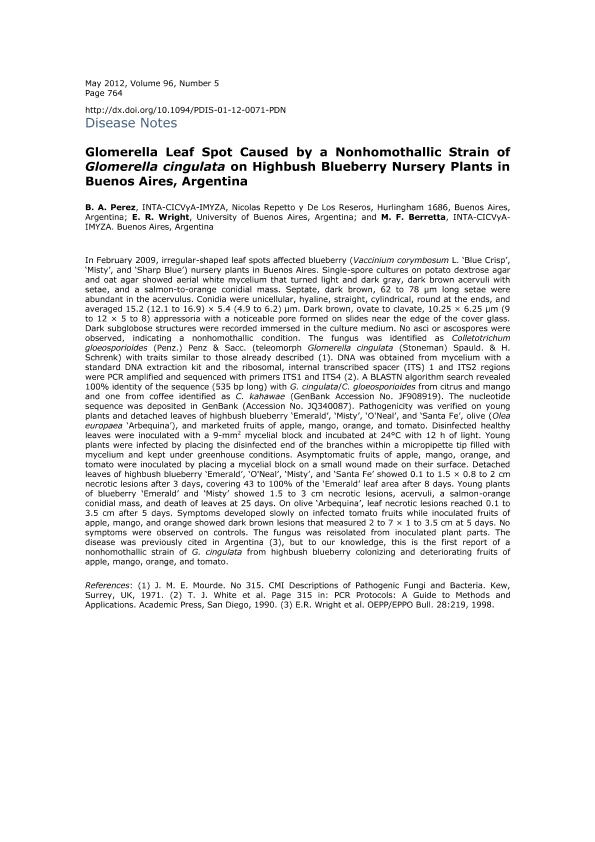Artículo
Glomerella Leaf Spot Caused by a Nonhomothallic Strain of Glomerella cingulata on Highbush Blueberry Nursery Plants in Buenos Aires, Argentina
Fecha de publicación:
05/2012
Editorial:
American Phytopathological Society
Revista:
Plant Disease
ISSN:
0191-2917
e-ISSN:
1943-7692
Idioma:
Inglés
Tipo de recurso:
Artículo publicado
Clasificación temática:
Resumen
In February 2009, irregular-shaped leaf spots affected blueberry (Vaccinium corymbosum L. ‘Blue Crisp’, ‘Misty’, and ‘Sharp Blue’) nursery plants in Buenos Aires. Single-spore cultures on potato dextrose agar and oat agar showed aerial white mycelium that turned light and dark gray, dark brown acervuli with setae, and a salmon-to-orange conidial mass. Septate, dark brown, 62 to 78 μm long setae were abundant in the acervulus. Conidia were unicellular, hyaline, straight, cylindrical, round at the ends, and averaged 15.2 (12.1 to 16.9) × 5.4 (4.9 to 6.2) μm. Dark brown, ovate to clavate, 10.25 × 6.25 μm (9 to 12 × 5 to 8) appressoria with a noticeable pore formed on slides near the edge of the cover glass. Dark subglobose structures were recorded immersed in the culture medium. No asci or ascospores were observed, indicating a nonhomothallic condition. The fungus was identified as Colletotrichum gloeosporioides (Penz.) Penz & Sacc. (teleomorph Glomerella cingulata (Stoneman) Spauld. & H. Schrenk) with traits similar to those already described (1). DNA was obtained from mycelium with a standard DNA extraction kit and the ribosomal, internal transcribed spacer (ITS) 1 and ITS2 regions were PCR amplified and sequenced with primers ITS1 and ITS4 (2). A BLASTN algorithm search revealed 100% identity of the sequence (535 bp long) with G. cingulata/C. gloeosporioides from citrus and mango and one from coffee identified as C. kahawae (GenBank Accession No. JF908919). The nucleotide sequence was deposited in GenBank (Accession No. JQ340087). Pathogenicity was verified on young plants and detached leaves of highbush blueberry ‘Emerald’, ‘Misty’, ‘O'Neal’, and ‘Santa Fe’, olive (Olea europaea ‘Arbequina’), and marketed fruits of apple, mango, orange, and tomato. Disinfected healthy leaves were inoculated with a 9-mm2 mycelial block and incubated at 24°C with 12 h of light. Young plants were infected by placing the disinfected end of the branches within a micropipette tip filled with mycelium and kept under greenhouse conditions. Asymptomatic fruits of apple, mango, orange, and tomato were inoculated by placing a mycelial block on a small wound made on their surface. Detached leaves of highbush blueberry ‘Emerald’, ‘O'Neal’, ‘Misty’, and ‘Santa Fe’ showed 0.1 to 1.5 × 0.8 to 2 cm necrotic lesions after 3 days, covering 43 to 100% of the ‘Emerald’ leaf area after 8 days. Young plants of blueberry ‘Emerald’ and ‘Misty’ showed 1.5 to 3 cm necrotic lesions, acervuli, a salmon-orange conidial mass, and death of leaves at 25 days. On olive ‘Arbequina’, leaf necrotic lesions reached 0.1 to 3.5 cm after 5 days. Symptoms developed slowly on infected tomato fruits while inoculated fruits of apple, mango, and orange showed dark brown lesions that measured 2 to 7 × 1 to 3.5 cm at 5 days. No symptoms were observed on controls. The fungus was reisolated from inoculated plant parts. The disease was previously cited in Argentina (3), but to our knowledge, this is the first report of a nonhomothallic strain of G. cingulata from highbush blueberry colonizing and deteriorating fruits of apple, mango, orange, and tomato.
Palabras clave:
GLOMERELLA
,
BLUEBERRY
Archivos asociados
Licencia
Identificadores
Colecciones
Articulos(SEDE CENTRAL)
Articulos de SEDE CENTRAL
Articulos de SEDE CENTRAL
Citación
Perez, Beatriz Alida; Wright, Eduardo Roberto; Berretta, Marcelo Facundo; Glomerella Leaf Spot Caused by a Nonhomothallic Strain of Glomerella cingulata on Highbush Blueberry Nursery Plants in Buenos Aires, Argentina; American Phytopathological Society; Plant Disease; 96; 5; 5-2012; 764-764
Compartir
Altmétricas




